Management: Planning and Implementing a Coaching Strategy Report
VerifiedAdded on 2022/09/11
|9
|1541
|31
Report
AI Summary
This report, prepared as part of a management course, provides a detailed analysis of coaching strategies within an organizational context. The report begins by identifying the need for coaching, emphasizing its importance for successful organizational performance and exploring various sources that highlight this need. It then outlines the key components of a coaching strategy, including joint planning, observation, action-taking, and feedback mechanisms. The report identifies the roles and responsibilities of individuals involved in the coaching program, such as organizational leaders, managers, and coaches, and details the specific duties of a coach, including providing resources, setting goals, and exploring past successes. It also discusses stakeholders who can aid in developing timelines for the coaching strategy and explores different coaching models like GROW and OSKAR. Furthermore, the report addresses legal and ethical compliance, criteria for matching coaches with trainees, and professional development activities for coaches. Finally, it examines methods for monitoring coaching relationships, ensuring the effectiveness of the coaching program. The report concludes with a comprehensive list of references and bibliography.
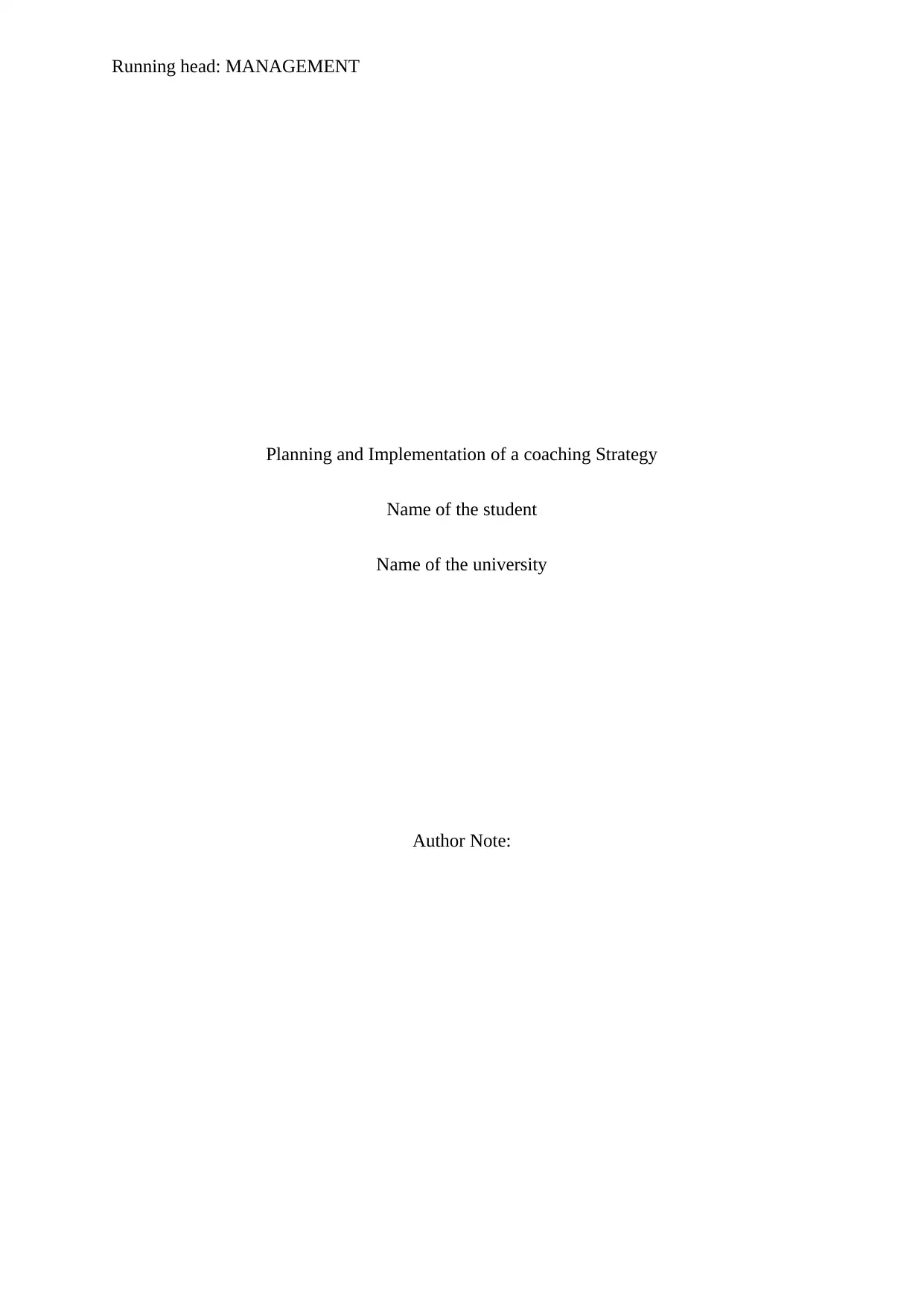
Running head: MANAGEMENT
Planning and Implementation of a coaching Strategy
Name of the student
Name of the university
Author Note:
Planning and Implementation of a coaching Strategy
Name of the student
Name of the university
Author Note:
Paraphrase This Document
Need a fresh take? Get an instant paraphrase of this document with our AI Paraphraser
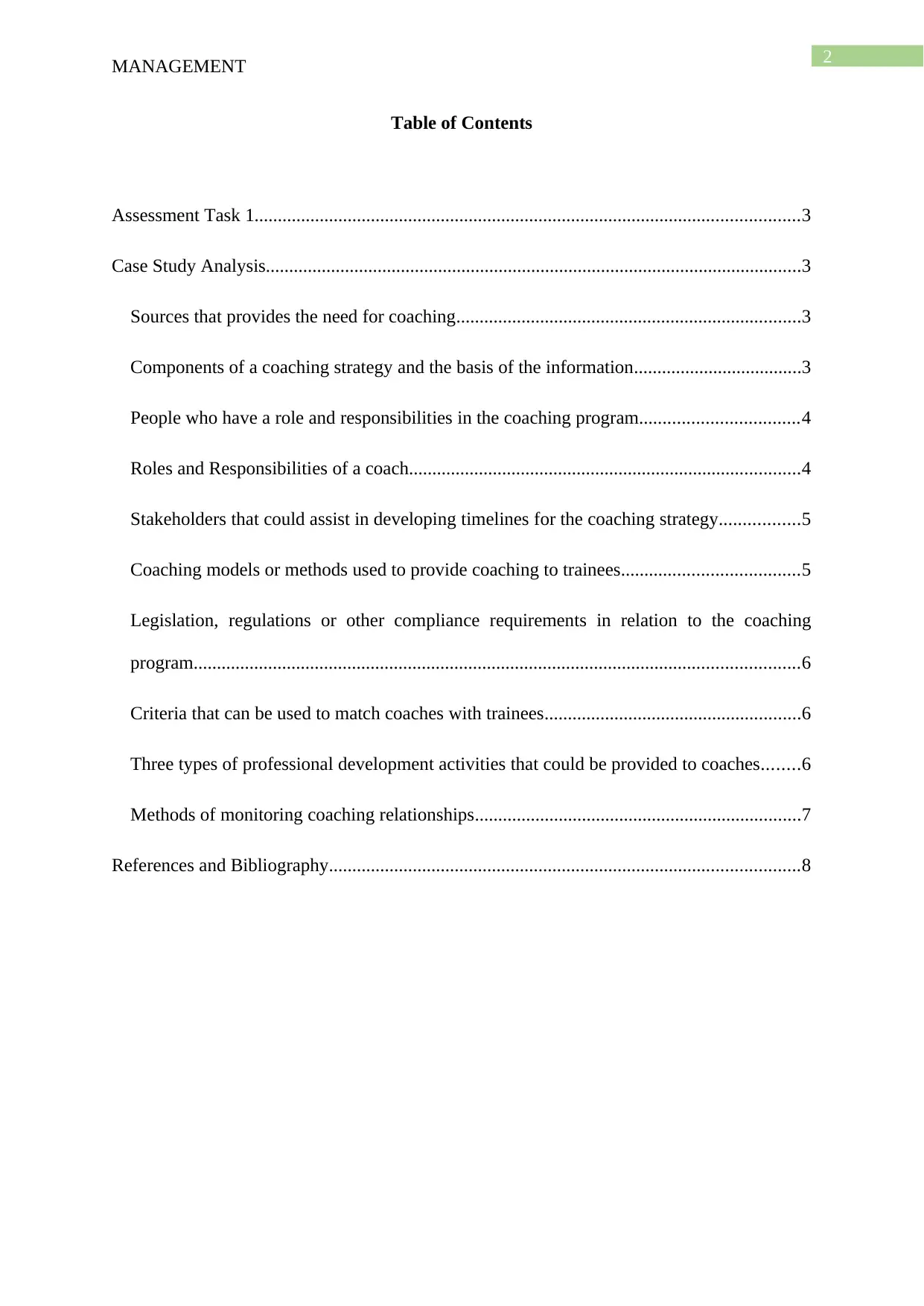
2
MANAGEMENT
Table of Contents
Assessment Task 1.....................................................................................................................3
Case Study Analysis...................................................................................................................3
Sources that provides the need for coaching..........................................................................3
Components of a coaching strategy and the basis of the information....................................3
People who have a role and responsibilities in the coaching program..................................4
Roles and Responsibilities of a coach....................................................................................4
Stakeholders that could assist in developing timelines for the coaching strategy.................5
Coaching models or methods used to provide coaching to trainees......................................5
Legislation, regulations or other compliance requirements in relation to the coaching
program..................................................................................................................................6
Criteria that can be used to match coaches with trainees.......................................................6
Three types of professional development activities that could be provided to coaches........6
Methods of monitoring coaching relationships......................................................................7
References and Bibliography.....................................................................................................8
MANAGEMENT
Table of Contents
Assessment Task 1.....................................................................................................................3
Case Study Analysis...................................................................................................................3
Sources that provides the need for coaching..........................................................................3
Components of a coaching strategy and the basis of the information....................................3
People who have a role and responsibilities in the coaching program..................................4
Roles and Responsibilities of a coach....................................................................................4
Stakeholders that could assist in developing timelines for the coaching strategy.................5
Coaching models or methods used to provide coaching to trainees......................................5
Legislation, regulations or other compliance requirements in relation to the coaching
program..................................................................................................................................6
Criteria that can be used to match coaches with trainees.......................................................6
Three types of professional development activities that could be provided to coaches........6
Methods of monitoring coaching relationships......................................................................7
References and Bibliography.....................................................................................................8

3
MANAGEMENT
Assessment Task 1
Case Study Analysis
Sources that provides the need for coaching
The presence of a proper training activity is highly important for any kind of
successful organization and therefore the presence of a proper and effective coaching method
is highly necessary for the organizations. The presence of an extensive and excellent training
program is highly important for the management of a successful organization (Aarons et
al.2017). Therefore some of the major sources that can provide the needs for coaching
activities include the likes of;
a. Exploring an overall performance by proper study and proper examination
b. Comparison with other assessments
c. Consideration of the industry
d. Different kinds of the training programs for the analysis of the different kinds of the
roles
Components of a coaching strategy and the basis of the information
There are a number of different components of a coaching strategy. The components
of coaching strategy includes the likes of;
a. Joint Planning- The joint planning will be based on the assessment of the priorities of
the organizations on a joint basis, decisions on the target of the routines, and the
review of the different organizational goals.
b. Proper Observation- The proper and thorough observation will be based on the
observation of the skills that the trainee displays, engagement of the trainees in the
related activities and observation of the reaction of the trainees.
MANAGEMENT
Assessment Task 1
Case Study Analysis
Sources that provides the need for coaching
The presence of a proper training activity is highly important for any kind of
successful organization and therefore the presence of a proper and effective coaching method
is highly necessary for the organizations. The presence of an extensive and excellent training
program is highly important for the management of a successful organization (Aarons et
al.2017). Therefore some of the major sources that can provide the needs for coaching
activities include the likes of;
a. Exploring an overall performance by proper study and proper examination
b. Comparison with other assessments
c. Consideration of the industry
d. Different kinds of the training programs for the analysis of the different kinds of the
roles
Components of a coaching strategy and the basis of the information
There are a number of different components of a coaching strategy. The components
of coaching strategy includes the likes of;
a. Joint Planning- The joint planning will be based on the assessment of the priorities of
the organizations on a joint basis, decisions on the target of the routines, and the
review of the different organizational goals.
b. Proper Observation- The proper and thorough observation will be based on the
observation of the skills that the trainee displays, engagement of the trainees in the
related activities and observation of the reaction of the trainees.
⊘ This is a preview!⊘
Do you want full access?
Subscribe today to unlock all pages.

Trusted by 1+ million students worldwide
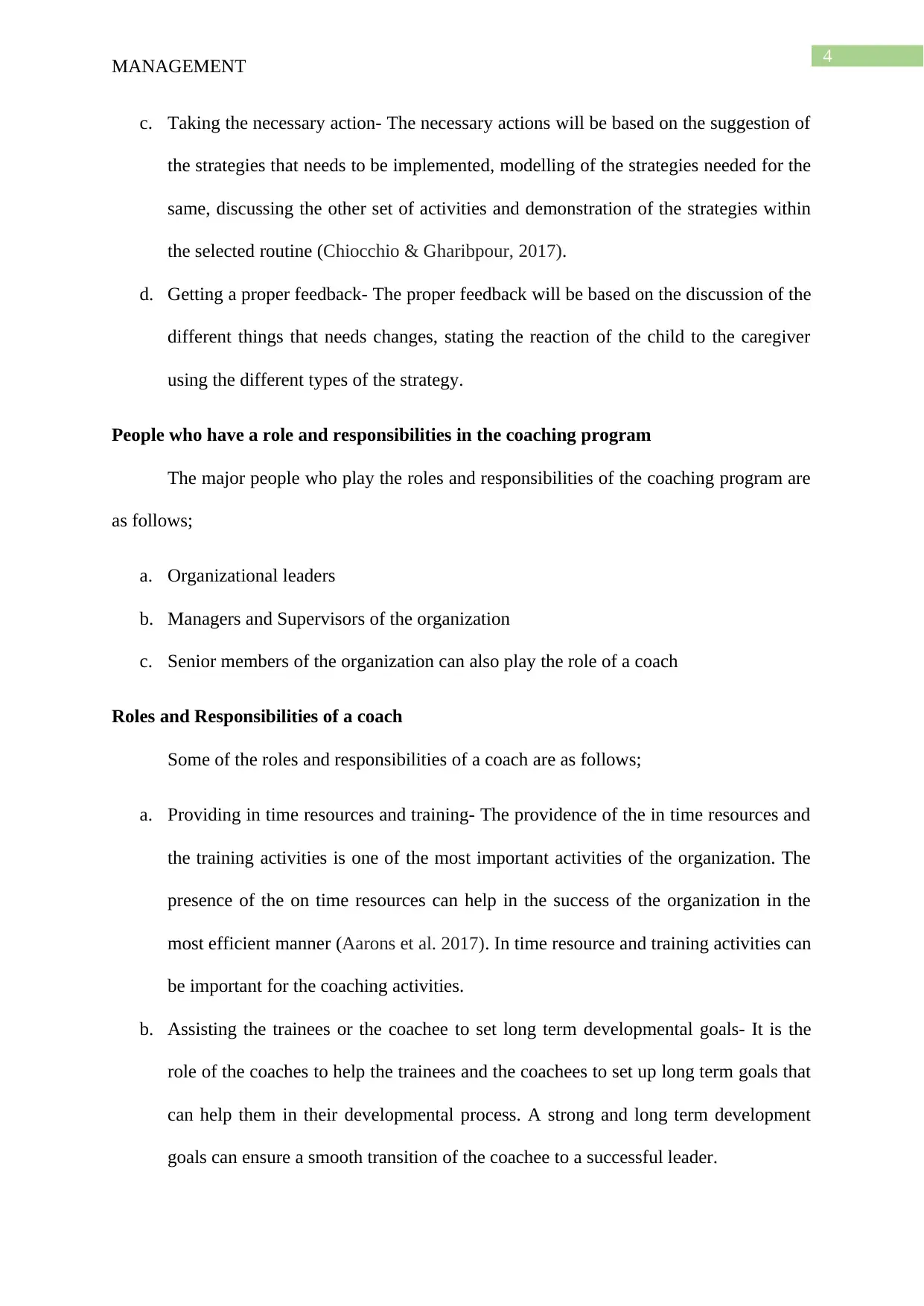
4
MANAGEMENT
c. Taking the necessary action- The necessary actions will be based on the suggestion of
the strategies that needs to be implemented, modelling of the strategies needed for the
same, discussing the other set of activities and demonstration of the strategies within
the selected routine (Chiocchio & Gharibpour, 2017).
d. Getting a proper feedback- The proper feedback will be based on the discussion of the
different things that needs changes, stating the reaction of the child to the caregiver
using the different types of the strategy.
People who have a role and responsibilities in the coaching program
The major people who play the roles and responsibilities of the coaching program are
as follows;
a. Organizational leaders
b. Managers and Supervisors of the organization
c. Senior members of the organization can also play the role of a coach
Roles and Responsibilities of a coach
Some of the roles and responsibilities of a coach are as follows;
a. Providing in time resources and training- The providence of the in time resources and
the training activities is one of the most important activities of the organization. The
presence of the on time resources can help in the success of the organization in the
most efficient manner (Aarons et al. 2017). In time resource and training activities can
be important for the coaching activities.
b. Assisting the trainees or the coachee to set long term developmental goals- It is the
role of the coaches to help the trainees and the coachees to set up long term goals that
can help them in their developmental process. A strong and long term development
goals can ensure a smooth transition of the coachee to a successful leader.
MANAGEMENT
c. Taking the necessary action- The necessary actions will be based on the suggestion of
the strategies that needs to be implemented, modelling of the strategies needed for the
same, discussing the other set of activities and demonstration of the strategies within
the selected routine (Chiocchio & Gharibpour, 2017).
d. Getting a proper feedback- The proper feedback will be based on the discussion of the
different things that needs changes, stating the reaction of the child to the caregiver
using the different types of the strategy.
People who have a role and responsibilities in the coaching program
The major people who play the roles and responsibilities of the coaching program are
as follows;
a. Organizational leaders
b. Managers and Supervisors of the organization
c. Senior members of the organization can also play the role of a coach
Roles and Responsibilities of a coach
Some of the roles and responsibilities of a coach are as follows;
a. Providing in time resources and training- The providence of the in time resources and
the training activities is one of the most important activities of the organization. The
presence of the on time resources can help in the success of the organization in the
most efficient manner (Aarons et al. 2017). In time resource and training activities can
be important for the coaching activities.
b. Assisting the trainees or the coachee to set long term developmental goals- It is the
role of the coaches to help the trainees and the coachees to set up long term goals that
can help them in their developmental process. A strong and long term development
goals can ensure a smooth transition of the coachee to a successful leader.
Paraphrase This Document
Need a fresh take? Get an instant paraphrase of this document with our AI Paraphraser
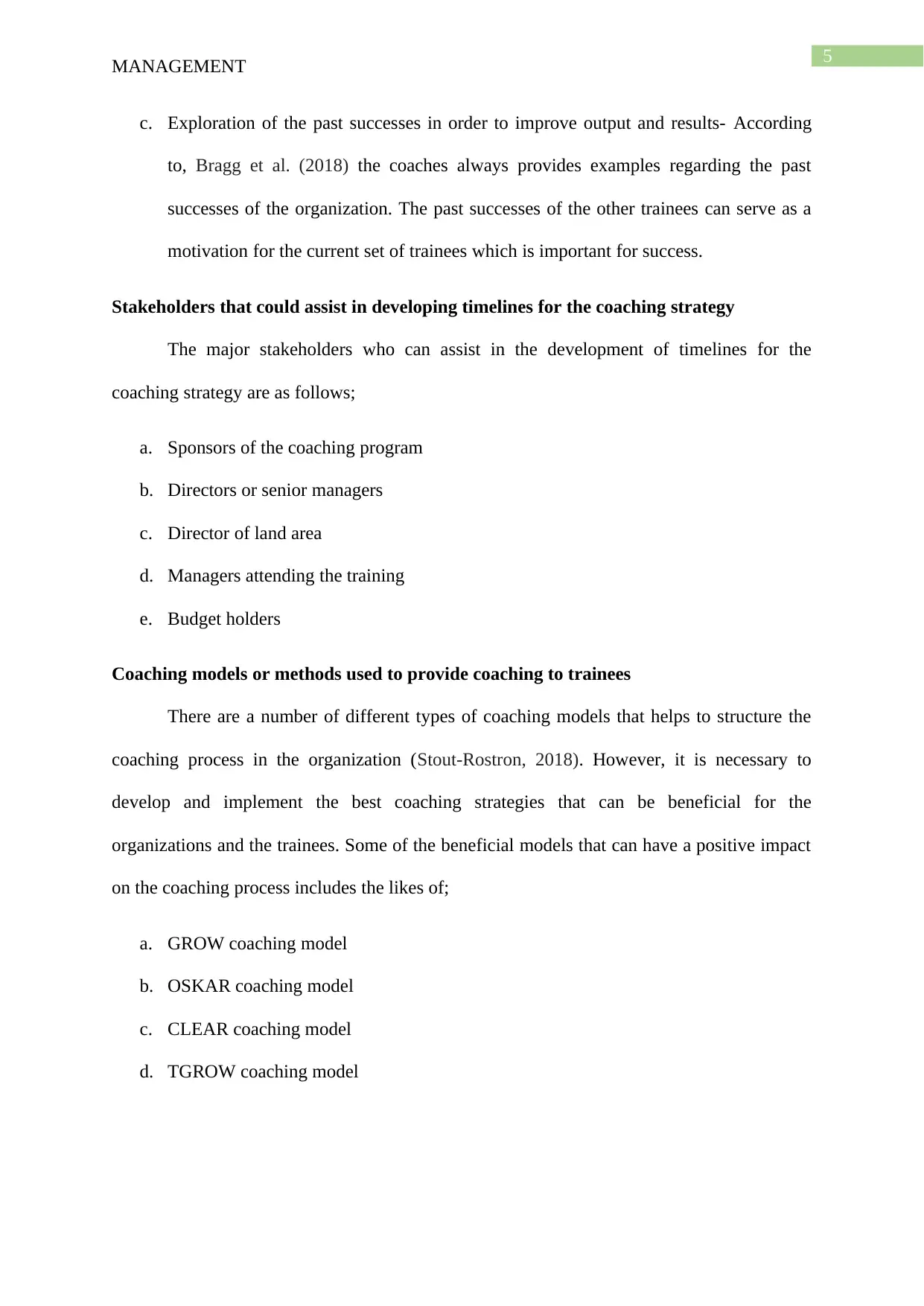
5
MANAGEMENT
c. Exploration of the past successes in order to improve output and results- According
to, Bragg et al. (2018) the coaches always provides examples regarding the past
successes of the organization. The past successes of the other trainees can serve as a
motivation for the current set of trainees which is important for success.
Stakeholders that could assist in developing timelines for the coaching strategy
The major stakeholders who can assist in the development of timelines for the
coaching strategy are as follows;
a. Sponsors of the coaching program
b. Directors or senior managers
c. Director of land area
d. Managers attending the training
e. Budget holders
Coaching models or methods used to provide coaching to trainees
There are a number of different types of coaching models that helps to structure the
coaching process in the organization (Stout-Rostron, 2018). However, it is necessary to
develop and implement the best coaching strategies that can be beneficial for the
organizations and the trainees. Some of the beneficial models that can have a positive impact
on the coaching process includes the likes of;
a. GROW coaching model
b. OSKAR coaching model
c. CLEAR coaching model
d. TGROW coaching model
MANAGEMENT
c. Exploration of the past successes in order to improve output and results- According
to, Bragg et al. (2018) the coaches always provides examples regarding the past
successes of the organization. The past successes of the other trainees can serve as a
motivation for the current set of trainees which is important for success.
Stakeholders that could assist in developing timelines for the coaching strategy
The major stakeholders who can assist in the development of timelines for the
coaching strategy are as follows;
a. Sponsors of the coaching program
b. Directors or senior managers
c. Director of land area
d. Managers attending the training
e. Budget holders
Coaching models or methods used to provide coaching to trainees
There are a number of different types of coaching models that helps to structure the
coaching process in the organization (Stout-Rostron, 2018). However, it is necessary to
develop and implement the best coaching strategies that can be beneficial for the
organizations and the trainees. Some of the beneficial models that can have a positive impact
on the coaching process includes the likes of;
a. GROW coaching model
b. OSKAR coaching model
c. CLEAR coaching model
d. TGROW coaching model

6
MANAGEMENT
Legislation, regulations or other compliance requirements in relation to the coaching
program
According to, Bragg et al. (2018) there are a number of different guidelines and legal
and ethical compliances that are needed for the relation to the coaching program of the
organization. The coaching program has to follow some legal and ethical guidelines that can
help ensure the success of the organization in a proper and ethical manner. The proper
implementation of the NHFS coaches association guidelines and the presence of a strategic
long term behaviour is crucial for business success.
Criteria that can be used to match coaches with trainees
Some of the major criteria that can help to match the coaches and the trainees include
the likes of;
1. Matching of the skills
2. Managing the purpose for the engagement of a coach
3. Identification of the prospective coaches
4. Matching the different kinds of the prospective coaching techniques
5. Identification of the level of comfort
6. Coaching sense of support
7. Active listening techniques
8. Psychological study
Three types of professional development activities that could be provided to coaches
Some of the major professional development activities that can be provided to the
coaches are as follows;
MANAGEMENT
Legislation, regulations or other compliance requirements in relation to the coaching
program
According to, Bragg et al. (2018) there are a number of different guidelines and legal
and ethical compliances that are needed for the relation to the coaching program of the
organization. The coaching program has to follow some legal and ethical guidelines that can
help ensure the success of the organization in a proper and ethical manner. The proper
implementation of the NHFS coaches association guidelines and the presence of a strategic
long term behaviour is crucial for business success.
Criteria that can be used to match coaches with trainees
Some of the major criteria that can help to match the coaches and the trainees include
the likes of;
1. Matching of the skills
2. Managing the purpose for the engagement of a coach
3. Identification of the prospective coaches
4. Matching the different kinds of the prospective coaching techniques
5. Identification of the level of comfort
6. Coaching sense of support
7. Active listening techniques
8. Psychological study
Three types of professional development activities that could be provided to coaches
Some of the major professional development activities that can be provided to the
coaches are as follows;
⊘ This is a preview!⊘
Do you want full access?
Subscribe today to unlock all pages.

Trusted by 1+ million students worldwide
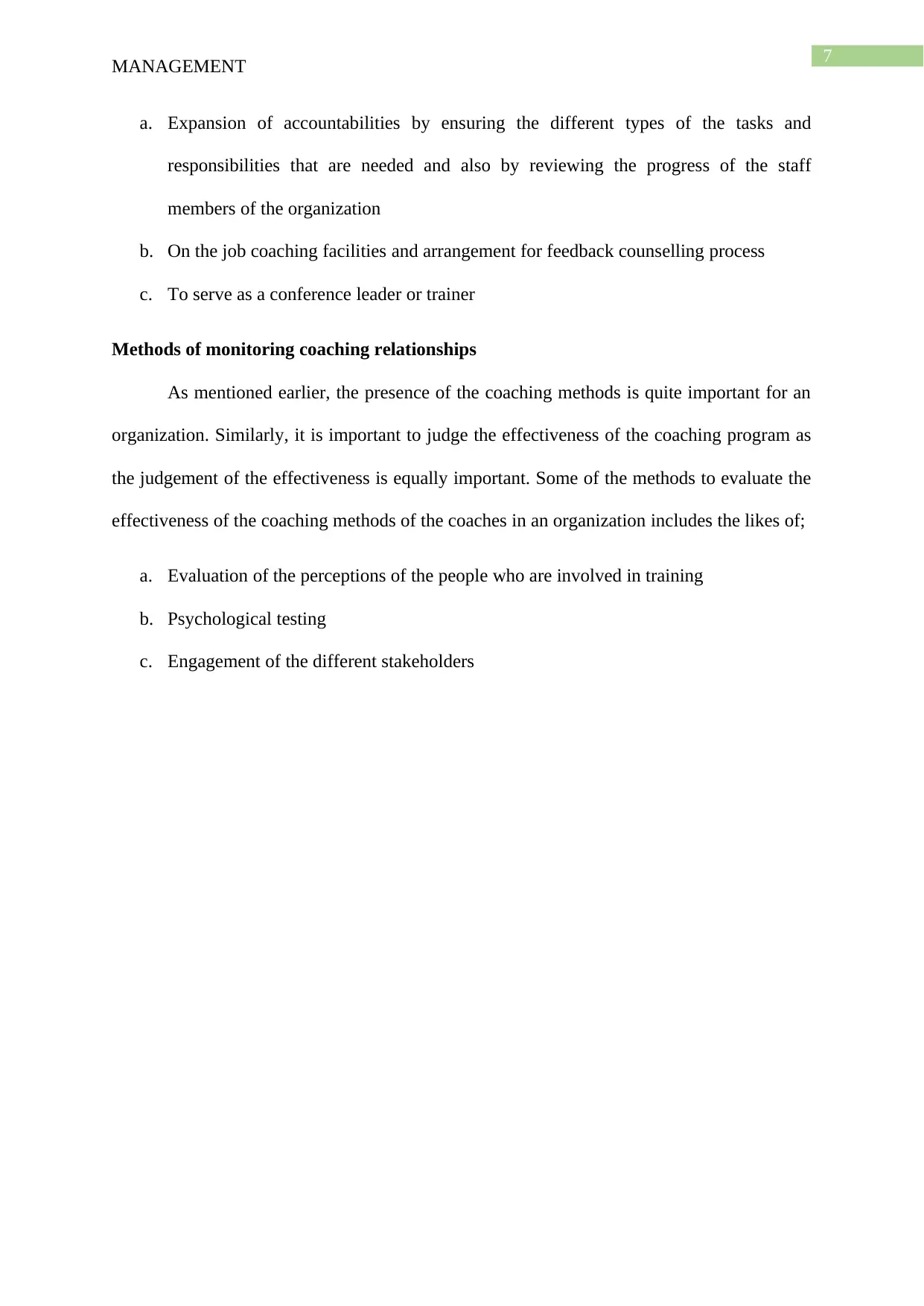
7
MANAGEMENT
a. Expansion of accountabilities by ensuring the different types of the tasks and
responsibilities that are needed and also by reviewing the progress of the staff
members of the organization
b. On the job coaching facilities and arrangement for feedback counselling process
c. To serve as a conference leader or trainer
Methods of monitoring coaching relationships
As mentioned earlier, the presence of the coaching methods is quite important for an
organization. Similarly, it is important to judge the effectiveness of the coaching program as
the judgement of the effectiveness is equally important. Some of the methods to evaluate the
effectiveness of the coaching methods of the coaches in an organization includes the likes of;
a. Evaluation of the perceptions of the people who are involved in training
b. Psychological testing
c. Engagement of the different stakeholders
MANAGEMENT
a. Expansion of accountabilities by ensuring the different types of the tasks and
responsibilities that are needed and also by reviewing the progress of the staff
members of the organization
b. On the job coaching facilities and arrangement for feedback counselling process
c. To serve as a conference leader or trainer
Methods of monitoring coaching relationships
As mentioned earlier, the presence of the coaching methods is quite important for an
organization. Similarly, it is important to judge the effectiveness of the coaching program as
the judgement of the effectiveness is equally important. Some of the methods to evaluate the
effectiveness of the coaching methods of the coaches in an organization includes the likes of;
a. Evaluation of the perceptions of the people who are involved in training
b. Psychological testing
c. Engagement of the different stakeholders
Paraphrase This Document
Need a fresh take? Get an instant paraphrase of this document with our AI Paraphraser
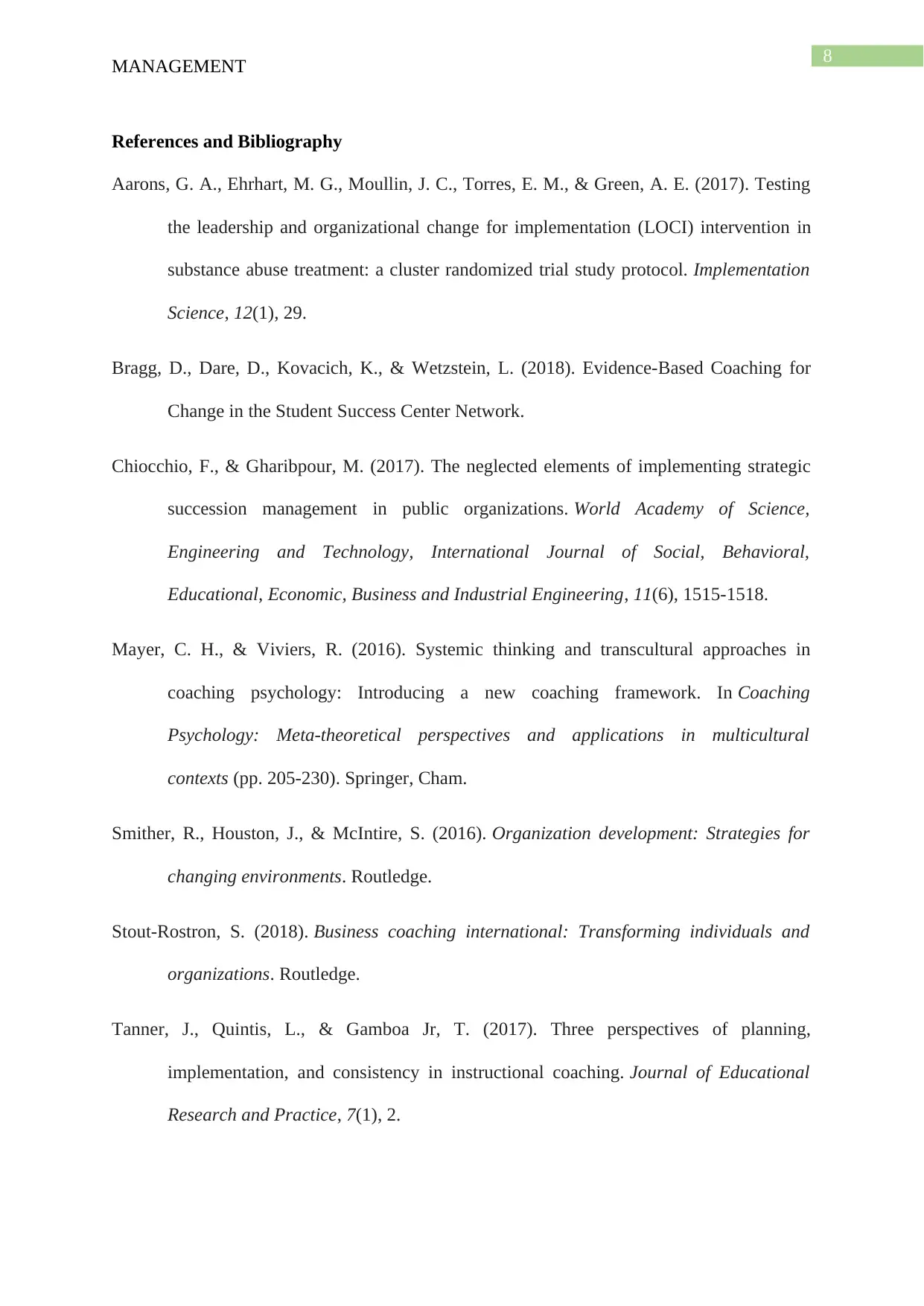
8
MANAGEMENT
References and Bibliography
Aarons, G. A., Ehrhart, M. G., Moullin, J. C., Torres, E. M., & Green, A. E. (2017). Testing
the leadership and organizational change for implementation (LOCI) intervention in
substance abuse treatment: a cluster randomized trial study protocol. Implementation
Science, 12(1), 29.
Bragg, D., Dare, D., Kovacich, K., & Wetzstein, L. (2018). Evidence-Based Coaching for
Change in the Student Success Center Network.
Chiocchio, F., & Gharibpour, M. (2017). The neglected elements of implementing strategic
succession management in public organizations. World Academy of Science,
Engineering and Technology, International Journal of Social, Behavioral,
Educational, Economic, Business and Industrial Engineering, 11(6), 1515-1518.
Mayer, C. H., & Viviers, R. (2016). Systemic thinking and transcultural approaches in
coaching psychology: Introducing a new coaching framework. In Coaching
Psychology: Meta-theoretical perspectives and applications in multicultural
contexts (pp. 205-230). Springer, Cham.
Smither, R., Houston, J., & McIntire, S. (2016). Organization development: Strategies for
changing environments. Routledge.
Stout-Rostron, S. (2018). Business coaching international: Transforming individuals and
organizations. Routledge.
Tanner, J., Quintis, L., & Gamboa Jr, T. (2017). Three perspectives of planning,
implementation, and consistency in instructional coaching. Journal of Educational
Research and Practice, 7(1), 2.
MANAGEMENT
References and Bibliography
Aarons, G. A., Ehrhart, M. G., Moullin, J. C., Torres, E. M., & Green, A. E. (2017). Testing
the leadership and organizational change for implementation (LOCI) intervention in
substance abuse treatment: a cluster randomized trial study protocol. Implementation
Science, 12(1), 29.
Bragg, D., Dare, D., Kovacich, K., & Wetzstein, L. (2018). Evidence-Based Coaching for
Change in the Student Success Center Network.
Chiocchio, F., & Gharibpour, M. (2017). The neglected elements of implementing strategic
succession management in public organizations. World Academy of Science,
Engineering and Technology, International Journal of Social, Behavioral,
Educational, Economic, Business and Industrial Engineering, 11(6), 1515-1518.
Mayer, C. H., & Viviers, R. (2016). Systemic thinking and transcultural approaches in
coaching psychology: Introducing a new coaching framework. In Coaching
Psychology: Meta-theoretical perspectives and applications in multicultural
contexts (pp. 205-230). Springer, Cham.
Smither, R., Houston, J., & McIntire, S. (2016). Organization development: Strategies for
changing environments. Routledge.
Stout-Rostron, S. (2018). Business coaching international: Transforming individuals and
organizations. Routledge.
Tanner, J., Quintis, L., & Gamboa Jr, T. (2017). Three perspectives of planning,
implementation, and consistency in instructional coaching. Journal of Educational
Research and Practice, 7(1), 2.
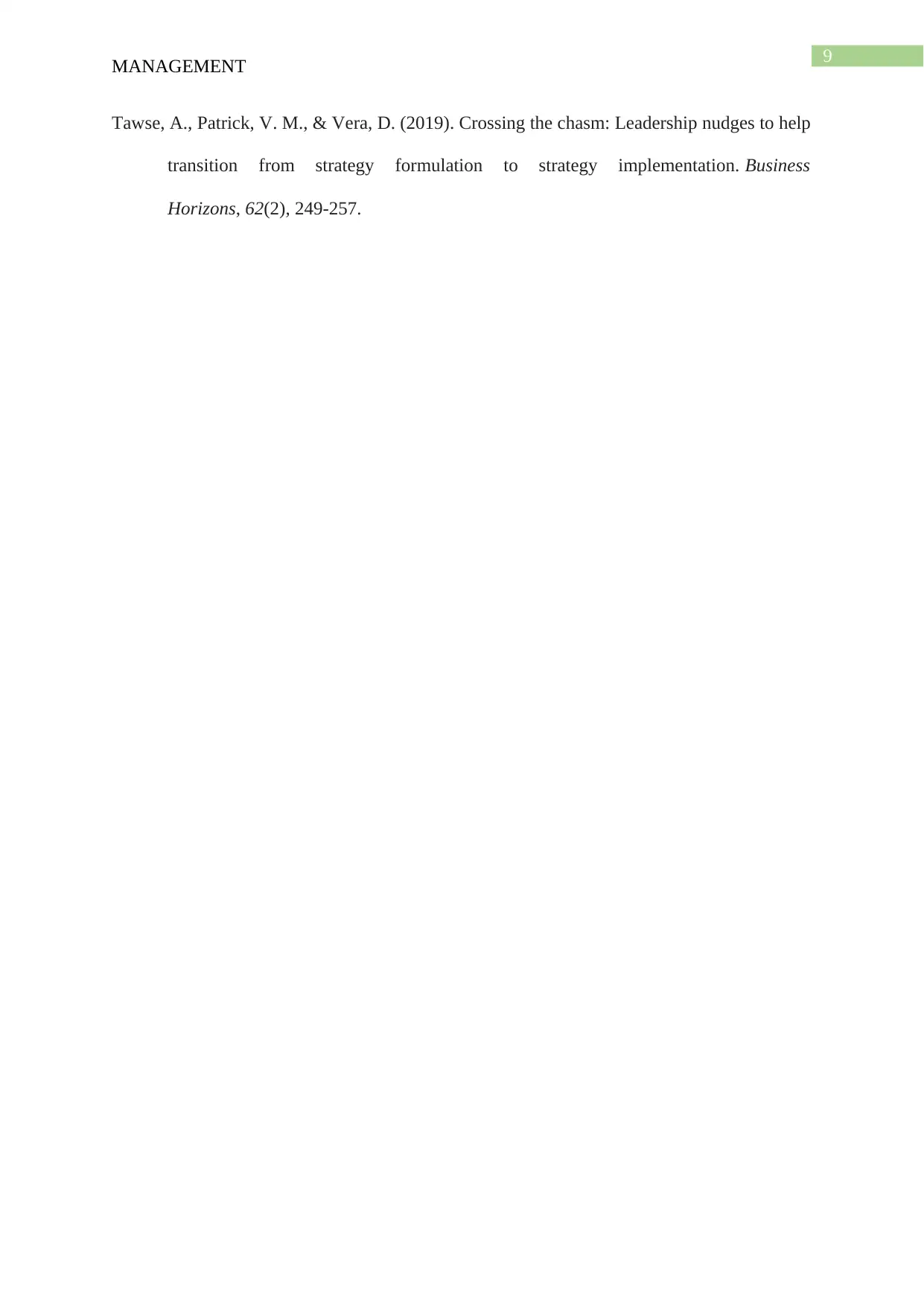
9
MANAGEMENT
Tawse, A., Patrick, V. M., & Vera, D. (2019). Crossing the chasm: Leadership nudges to help
transition from strategy formulation to strategy implementation. Business
Horizons, 62(2), 249-257.
MANAGEMENT
Tawse, A., Patrick, V. M., & Vera, D. (2019). Crossing the chasm: Leadership nudges to help
transition from strategy formulation to strategy implementation. Business
Horizons, 62(2), 249-257.
⊘ This is a preview!⊘
Do you want full access?
Subscribe today to unlock all pages.

Trusted by 1+ million students worldwide
1 out of 9
Related Documents
Your All-in-One AI-Powered Toolkit for Academic Success.
+13062052269
info@desklib.com
Available 24*7 on WhatsApp / Email
![[object Object]](/_next/static/media/star-bottom.7253800d.svg)
Unlock your academic potential
Copyright © 2020–2025 A2Z Services. All Rights Reserved. Developed and managed by ZUCOL.





